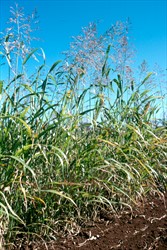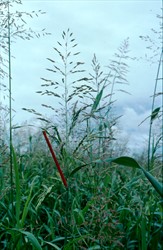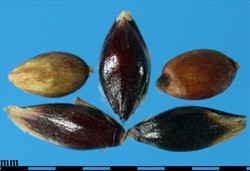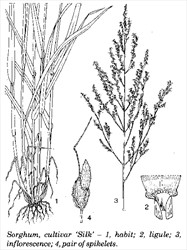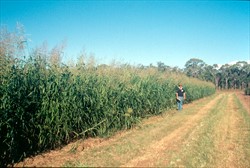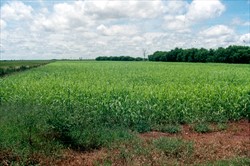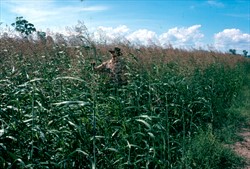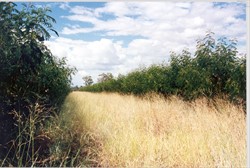Sorghum (perennial)
Tropical Forages
Sorghum halepense: Basionym: Holcus halepensis L.; Andropogon controversus Steud.; Andropogon halepensis (L.) Brot.; Andropogon halepensis var. anatherus Piper; Andropogon miliaceus Roxb.; Andropogon miliformis Schult.; Holcus exiguus Forssk.; Holcus halepensis var. miliformis (Schult.) Hitchc.; Holcus sorghum var. exiguus (Forssk.) Hitchc.; Sorghum controversum (Steud.) Snowden; Sorghum miliaceum (Roxb.) Snowden; Sorghum miliaceum var. parvispicula Snowden
Family: Poaceae (alt. Gramineae) subfamily: Panicoideae tribe: Andropogoneae subtribe: Sorghinae.
Sorghum × almum: Erect, robust (moreso than S. halepense), tussocky, short-lived perennial with numerous tillers 2‒ 3 (‒4.5) m tall, and short, thick, upward-curving rhizomes producing new shoots near the parent clump. Stems solid / pithy, to 1 cm thick, mostly unbranched; nodes glabrous or finely pubescent. Leaf blades linear, apex tapering, 30‒45 (‒100) cm long, 0.5‒2.5 (‒4.0) cm wide (wider than S. halepense), glaucescent; blade and sheath usually glabrous except for hairs near the membranous ligule; leaf blade margins scaberulous. Panicle pyramid-shaped, 20‒60 cm long, 8‒25 cm wide, with secondary and tertiary branches, the former in whorls; more open than in S. halepense, becoming moreso as seed ripens. Spikelets (each comprising a single floret) in pairs, one sessile and hermaphrodite, the other pedicellate and male; sessile spikelet 5‒6.5 mm long, 2‒5 mm wide, ovate-lanceolate, hairy when young; male pedicellate spikelet 5‒7 mm long, more or less persistent; pedicels hairy; glumes equal, rigid and shiny brown or black when mature, enclosing the caryopsis; lemma transparent, often with awn 1‒2 cm long, which readily falls off as the seed matures; palea transparent, longer than the lemma. Caryopsis light brown, ovate to obovate, 2.5‒4.0 mm long, 2‒2.3 mm wide. 130,000 seeds per kg; 180,000 caryopses per kg.
Sorghum halepense: Erect, rhizomatous, perennial, less robust than Sorghum × almum, growing (0.5‒) 1.0‒2.5 (‒3.5) m tall, and with more strongly developed rhizomes, to 2 m long, distributed mainly in the top 20 cm of soil, often rooting and shooting from the nodes. Stems mostly unbranched; nodes glabrous or finely pubescent. Leaf sheaths usually glabrous; ligule ciliate-membranous, 2 mm long; blades linear, apex tapering, to 60 cm long and 1‒2 (‒3) cm wide. Panicle open, lanceolate or pyramidal, (10‒) 15‒25 (‒55) cm long, 3–25 cm wide; secondary branches ascending; sessile spikelet 4‒5.5 (‒7) mm long, 1.5‒ 2.3 mm wide, comprising one fertile floret and one basal sterile lemma; caryopsis enclosed by straw-yellow, reddish brown to shiny black glumes, lemma of upper floret often with awn 1 (‒2) cm long, twisted at base; pedicellate spikelet(s) 4‒6.5 mm long, containing empty or staminate lemmas. Caryopsis reddish brown, obovoid, 2.5‒3.8 mm long, 1.5‒2 mm wide. 160,000 seeds per kg.
Distinguishing features
S. halepense: less robust plant, more strongly developed, elongating rhizomes; clean abscission at the base of the spikelet.
S. × almum: robust plant, short rhizomes, pedicellate spikelet breaks off with the uppermost portion of the pedicel at maturity.
Sorghum × almum:
Asia: 杂高梁 za gao liang (China); burakku sorugamu (Japan); batag, gau (Philippines); ya-sokum (Thailand)
English: almum grass, almum sorghum, Columbus grass, five-year sorghum, perennial sorghum, sorghum almum
Europe: sorgho d’Argentine, sorgho fourrager (French); Columbusgras, Kolumbusgras (German)
Latin America: capim cebada, capim masambará (Portuguese); almum, garaví, garaví perenne, pasto Colón, pasto Columbus, pasto sorgo almum, sorgo almum, sorgo de cuatro años, sorgo negro, sorgo negro argentino, sorgo perenne, Sudán negro, Sudán perenne (Spanish)
Sorghum halepense:
Afrikaans: Johnsongras
Asia: 石茅 shi mao; shi mao gao liang, si yong gao liang (China); barool (India); glagah rajoeng, pangan (Indonesia); ghiagh (Iran); seibanmorokoshi (Japan); hashishat-ul-faras (Lebanon); baru grass (Pakistan); aroró (Philippines, Bikol); baku (Philippines, Ifugao); batad-batádan, ngigai (Philippines, Tagalog); gumai (Russia); halaiyan; sifrand (Saudi Arabia); ya phong, ya poeng, ya pong (Thailand); gelis (Turkey)
English: Aleppo grass, Aleppo milletgrass, alwyn grass, Arabian millet, Cuba grass, Egyptian grass, Egyptian millet, evergreen millet, false guinea grass,
Europe: herbe d'alep, herbe de cuba, herbe de guinée, houlque d' alep, sorgho d'alep, sorgho fourrager (French); Aleppohirse, wilde Mohrenhirse (German); cannarecchia, sorgo selvatico (Italian); johnsongras (Netherlands)
Latin America: arroz bravo, capim do Alepo, capim argentino, capim aveia, capim cevada, capim-de-boi, capim de Cuba, capim de Johnson, capim Egipto, capim maçambará, capim-massambará, capim mexicano, sorgo de Allepo, maçambará, massambara, milho zaburro, peripomonga, sorgo-bravo, sorgo-de-alepo (Portuguese); cametillo, cañota, cañuela, canutillo, Don Carlos, grama China, hierba J
Pacific: mbangarnuis (Palau); kola (Tonga)
Sorghum spp. hybrids:
Commonly known by cultivar names, e.g. ‘Silk’, ‘Krish’
Sorghum × almum
Native:
South America: Argentina; Paraguay; Uruguay (see " Genetics/breeding")
Cultivated/naturalized:
Widely distributed throughout the sub-humid and semi-arid regions of the world tropics and subtropics
Sorghum halepense
Native:
Africa: Egypt; Libya
Asia: Afghanistan; Armenia; Azerbaijan; India; Iran; Iraq; Israel; Jordan; Kazakhstan (s.); Kyrgyzstan; Lebanon; Pakistan; Syria; Turkey; Turkmenistan; Uzbekistan
Naturalized:
Africa: north, Macaronesia; west tropical; west-central tropical; northeast tropical; southern tropical; south, and western Indian ocean
Americas: Northern America (USA, Mexico); Central America; South America:; Caribbean; northern South America; western South America; Brazil and southern South America
Asia: Central Asia; Caucasus; western Asia; Arabia; China; and eastern Asia; India; Indo-China; Malesia; and Papuasia
Australasia: Australia and New Zealand
Europe: central; southwestern; southeastern and eastern
Pacific: southwestern; south-central; northwestern and north-central
Forage
Both species produce vigorous medium-term (3‒5 years) pasture suitable for grazing, hay or silage. The coarse stems, particularly of S. × almum, are difficult to cure for hay making. S. halepense is generally not recommended because of its weediness. They can be used as pioneer species when sown with other more persistent, but slower-establishing, perennial grasses for quick cover and feed. Can be used for cut-and-carry. Seed of hybrids is often prohibitively expensive for use in smallholder systems.
Environment
While S. halepense can have a beneficial effect in reducing erosion, it has a negative effect on the environment in that it is considered one of the most serious weeds of cultivation.
Other
They have been used as a genetic base for breeding short and long-term perennial forages, providing improvements over parent types. Perennial sweet sorghums are being developed as forages but are also emerging as a potential energy source to compete with sugarcane (Saccharum officinarum).
Soil requirements
Sorghum × almum: Widely adapted, growing best on well-drained heavier soils but performing moderately well on fine sandy loams. pH range (5.0‒) 5.5‒7.0 (‒8.5). Responds well to fertility. Has remained productive for at least 10 years on fertile soils, but behaves as a short-term perennial on soils of low fertility. It is moderately salt-tolerant and a good pioneer on newly cleared land.
Sorghum halepense: Generally similar requirements to S. × almum, although more tolerant of periods of poor drainage. Adapted to a wide range of soil types, but prefers fertile porous soils with a pH between 5 and 7.5.
Both can "tie up" nutrient in their extensive root systems, reducing productivity of subsequent crops.
Moisture
Sorghum × almum: Best adapted to the summer rainfall areas with an average annual rainfall of (200‒) 500‒800 (‒2,000) mm. Extremely drought tolerant but intolerant of waterlogging.
Sorghum halepense: Not as drought tolerant as S. × almum, preferring a summer dominant average annual rainfall of (450‒) 500‒800 mm. It responds well to irrigation and, in the tropics, extends into areas with up to 3,000 mm rainfall. It is often found growing in ditches. Rhizomes survive dry periods, shooting again after rain.
Temperature
Sorghum × almum: Although originating in the sub-tropics of South America (24-hr average temperature 16.5 to about 23 °C), S. × almum can tolerate environments with 24-hr average temperature as low as 8.4 °C. Tops are killed by frost, but it has survived winter temperatures down to -15 °C. Regrowth from rhizomes occurs after light frosts.
Sorghum halepense: Found in moist tropics, sub-tropics and mediterranean climate zones (from about from 55° N to 45° S), adaptation varying with ecotypic origin. This suggests a wider adaptational range than S. × almum, with 24-hr average temperatures from about 7 to 27 °C. While most ecotypes are frost-sensitive, some have been able to over-winter in warm temperate zones of Europe, the United States and Canada. Plants are generally intolerant of hot, dry conditions which can lead to desiccation and rhizome death. Natural selection for deeper-growing rhizomes has allowed S. halepense to spread into colder areas, although the most cold-hardy biotypes reproduce mainly by seed.
Light
Both require full light for best growth.
Reproductive development
Sorghum × almum: A predominantly cross pollinated short-day plant. It can commence flowering 7‒8 weeks after planting and seeds profusely. Reports on seed retention capacity vary.
Sorghum halepense: Rhizomes which usually initiate a month or 45 days after emergence, coinciding with tillering or the 6‒7 leaf stage of shoot growth, are well developed by 6 to 7 weeks. While primarily a short-day plant, flowering times are highly variable, as they depend to a large extent on temperature. The seed requires after-ripening for a few months.
Defoliation
Sorghum × almum: Suitable for rotational grazing as it does not resist trampling. Valued for its good seed production, ease of establishment. It produces abundant good-quality herbage suitable for hay, silage, or grazing and is capable of sustaining very high stocking rates.
Sorghum halepense: Johnsongrass is cut for hay when flower-heads are still in the boot stage. Coarse stems dry slowly and thorough curing is necessary to produce good hay. Tends to become "sod-bound" after 2–3 years and may be renovated by plowing in spring and overseeding with legumes such as soybeans (Glycine max), cowpeas (Vigna unguiculata), or lablab (Lablab purpureus). May be cut for hay 2 or 3 times/season.
While early grazing reduces early flowering and development of coarse stems, stands should not be grazed before they reach 50 cm high to minimize the risk of prussic acid poisoning, nor below 15 cm to facilitate more vigorous regrowth. More mature stands are tolerant of short-term heavy grazing, regrowth occurring from axillary buds on the coarse stems remaining after grazing. However, both species are susceptible to trampling damage.
Fire
Not normally subjected to fires.
Guidelines for establishment and management of sown forages.
Establishment
Sown at 5‒7 kg/ha into covered furrows or at 20 kg/ha broadcast onto a prepared seedbed. Also sown at light seed rates (<5 kg/ha) with other grasses into ash after clearing bush, or after blade ploughing shrubby regrowth. Large seed germinates and establishes vigorously. S. halepense should not be sown at all.
Fertilizer
S. × almum and perennial Sorghum hybrids are fertility-demanding and are mostly grown only on fertile soils where little extra fertilizer is required.
Compatibility (with other species)
May be sown as a pioneer with more permanent grass species or with winter- or summer-growing legumes. However, there is evidence that S. × almum decreased the growth of associated Cenchrus americanus and Setaria italica, root and rhizosphere extracts showing allelopathic effects.
Companion species
Grasses: Sown with more permanent grasses such as Megathyrsus maximus, Panicum coloratum, Chloris gayana and Cenchrus ciliaris to assume dominance as the sorghum declines.
Legumes: Medicago sativa, annual medics (Medicago spp.), Neonotonia wightii, Lablab purpureus. Inter-row with Leucaena leucocephala.
Pests and diseases
Leaf and stem diseases are not often problems in forage sorghum because tops are usually harvested before the disease causes much damage. As stands mature, fungal leaf diseases such as blight caused by Helminthosporium turcicum, rust caused by Puccinia purpurea and gray leafspot caused by Ramulispora (Cercospora) sorghi become more prominent. Ergot, a disease of the inflorescence caused by the fungus, Claviceps africana, reduces seed yields. Bacterial leaf stripe caused by Burkholderia (Pseudomonas) andropogonis is considered to be a low to intermediate significance disease. Nematodes, including Meloidogyne incognita acrita and M. javanica have a negative effect on production, more so in lighter soils. Viruses including Johnsongrass mosaic virus (JGMV, maize dwarf mosaic virus, sugarcane mosaic virus) and sugarcane yellow leaf virus (SCYLV) have a significant effect in some areas. While many of these diseases are often have a fairly minor effect on sorghum crops, their main significance lies in the fact that these perennial Sorghum spp. act as an alternative host for the disease and a continuing source of inoculum to infect other crops such as maize (Zea mais), sugarcane (Saccharum officinarum) and grain sorghum (Sorghum bicolor).
Ability to spread
Can spread from seed dropping onto suitable arable land, and to a lesser extent by rhizome.
Weed potential
S. halepense is a serious environmental weed and weed of cultivation over a wide latitudinal range around the world. Sale of seed of S. × almum has been restricted for fear of reversion to the rhizomatous parent, S. halepense. Likewise, seed of cv. Silk has been restricted in some states of Australia for fear of contamination with seed of rhizomatous S. halepense which is similar in appearance to that of cv. Silk.
Nutritive value
The nutritive value greatly depends on soil fertility and stage of growth. Best quality feed is produced on more fertile soil. While Sorghum forage is more palatable and nutritious when young, it is also the stage when there is most danger of prussic acid poisoning in livestock (see Toxicity). More details on Feeding value can be found using the Feedipedia links below.
Palatability/acceptability
Both species produce very palatable forage when young, the palatability declining with age.
Toxicity
Under certain conditions, many, if not most Sorghum spp. tend to accumulate large quantities of cyanogenic glycosides, particularly in young growth. These glycosides can be converted in the rumen to highly toxic prussic acid / hydrocyanic acid (HCN), which enters the bloodstream, inhibiting oxygen utilisation by the cells, in effect, causing death from asphyxia. Because levels are highest in young growth, the risk of prussic acid poisoning in livestock is increased in new stands and under any condition where animals are likely to browse young growth in the absence of other roughage e.g. during droughts and particularly after drought breaks, when stressed, stunted plants begin to grow. The risk of prussic acid poisoning can be reduced by:
- Not allowing stock to graze young sorghum that is less than 50 cm high.
- Feeding hungry stock with safe roughage (e.g. hay) before allowing them to graze fresh-growth sorghum that may contain high levels of cyanogenic glycosides.
- Feeding only sorghum hay that was cut in a low-risk state, because there is no decrease in prussic acid content in the process of haymaking.
- Conserving doubtful material as silage because correct ensilage for 3 weeks reduces levels of toxin by approximately 50%.
- Supplementation of sulfur (if a deficiency exists), that increases the animal’s efficiency at converting prussic acid to the non-toxic thiocyanate.
Feedipedia link
https://www.feedipedia.org/node/378 (Sorghum × almum)
https://www.feedipedia.org/node/377 (Sorghum halepense)
Dry matter
DM yields up to 20 t/ha/yr, but more normally around 4–10 t/ha.
Animal production
Under continuous grazing in sub-humid Australia, steers grazing at stocking rates of 1.5–3 steers/ha averaged LWGs of 150 kg/head/year.
Sorghum halepense (2n = (20), 40, (43)) is believed to be the result of natural hybridization between the diploid (2n = 20) S. bicolor and S. propinquum, followed by a spontaneous doubling of the chromosome number to 40. S. × almum (2n = 40), which was first found in Argentina, is considered to be the result of a natural hybrid between S. halepense and S. bicolor, although there is doubt as to which subspecies of the latter might have been involved. S. × almum is predominately cross-pollinated, but also self-fertile, but hybridizes readily with S. halepense, as well as diploid subsp. bicolor and nothosubsp. drummondii. Both S. halepense and S. × almum have been used in breeding programs to produce perennial forage and grain sorghum varieties.
S. × almum commences flowering about 7‒8 weeks after sowing and is predominantly cross pollinated. It seeds profusely with very little seed being shed after ripening. Seed yields up to 1,500 kg/ha have been measured, but commercial crops are more often in the range of 250‒750 kg/ha. Since seed of the various hybrids is similar in appearance to that of the noxious weed, S. halepense, care should be taken with the purity of seed crops.
Atrazine can be used for pre- and post-plant, pre- and post-emergent grass and broad-leaf weed control, but should not be used on light sandy soils under irrigation. Manufacturer's recommendations on rates and soil moisture conditions should be followed carefully. 2, 4-D can be used with care for broadleaf weed control at the seedling stage when sorghum plants are 7‒15 cm high. Fluoxypyr may be used to control broadleaf weeds post-emergent when secondary roots have developed. These herbicides should not be used if a companion legume is sown. Seedlings and young plants of forage sorghum in other crops can be eradicated with non-residual contact herbicides or with glyphosate.
- Easy establishment and rapid growth.
- Very productive on fertile soils.
- Pioneer species with other perennial grasses or legumes.
- Demand high soil fertility.
- Risks associated with prussic acid poisoning.
- S. × almum seed cannot be distinguished from that of S. halepense.
- Can be very competitive and possibly have allelopathic effect on associated grasses.
- Difficult to eradicate from subsequent grain crops.
Bogdan, A.V. (1977) Tropical Pasture and Fodder Plants. Longman Inc., New York, USA. p. 273–282.
Davies, J.G. and Edye, L.A. (1959) Sorghum almum Parodi, a valuable summer growing grass. Journal of the Australian Institute of Agricultural Science 25:117–127.
Gates, C.T., Haydock, K.P., Claringbold, J.P. and Robbins, M.F. (1966) Growth of sorghum varieties of three sorghum species at different levels of salinity. Australian Journal of Experimental Agriculture and Animal Husbandry 6:161–169. doi.org/10.1071/EA9660161
Hacker, J.B. (1992) Sorghum x almum Parodi In: Mannetje, L.’t and Jones, R.M. (eds) Plant Resources of South-East Asia No. 4. Forages. Pudoc Scientific Publishers, Wageningen, the Netherlands. p. 206–208. edepot.wur.nl/327785
Jessup, R.W., Klein, R.R., Burson, B.L., Murray, S.C., Washburn, J.D., Heitholt, J.J. and Foster, J.L. (2017) Registration of perennial Sorghum bicolor × S. propinquum Line PSH12TX09. Journal of Plant Registrations 11:76–79. doi.org/10.3198/jpr2015.09.0054crgs
Parodi, L.R. (1943) Una nueva especie de "Sorghum" cultivada en la Argentina. Revista Argentina de Agronomía 10:361–372.
Pritchard, A.J. (1965) Aneuploidy in Sorghum almum Parodi and Sorghum halepense (L.) Pers. Australian Journal of Agricultural Research 16:517–523. doi.org/10.1071/AR9650517
Pritchard, A.J. (1965) Inheritance patterns in hybrids between Sorghum almum Parodi and perennial sweet Sudan grass. Australian Journal of Agricultural Research 16:525–532. doi.org/10.1071/AR9650525
Pritchard, A.J. (1964) Comparative trials with Sorghum almum and other forage sorghums in southeast Queensland. Australian Journal of Experimental Agriculture and Animal Husbandry 4:6–14. doi.org/10.1071/EA9640006
Pritchard, A.J. (1965) Inheritance of two seedling characters in Sorghum almum Parodi and cross pollination within Sorghum almum and S. halepense (L.) Pers. Australian Journal of Agricultural Research 16:533–540. doi.org/10.1071/AR9650533
Stuart, P.N. (2002) The Forage Book: A comprehensive guide to forage management. 2nd edition. Pacific Seeds, Toowoomba, Queensland, Australia.
Yates, J.J., Edye, L.A., Davies, J.G. and Haydock, K.P. (1964) Animal production from a Sorghum almum pasture in south-east Queensland. Australian Journal of Experimental Agriculture and Animal Husbandry 4:326–335. doi.org/10.1071/EA9640326
'Crooble' Sorghum × almum released in Australia prior to 1971. Developed from CPI 12019, an introduction from the College of Agriculture, Potchefstroom, South Africa. Adapted to the summer rainfall areas in the subtropics. Has remained productive for at least 10 years on fertile soils. Susceptible to leaf disease.
‘Krish’ Released in Australia (1967). Diploid hybrid between diploid form of S. halepense and S. subsp. bicolor. Poor seedling vigour and slow growth in spring. Flowers in May (later than 'Silk') in SE Queensland. Rhizomes almost entirely absent. Better resistance to fungal leaf diseases and SCMV and better palatability than Sorghum × almum.
‘Silk’ Released in Australia (1978). Tetraploid hybrid between ‘Krish’ and S. subsp. verticilliflorum. Rapid early growth, early tillering and an ability to compete with weeds. Flowers 2‒3 weeks later than S. × almum, and higher yielding. Resistance to leaf diseases; holds green leaf longer into early winter.
'Jaffa' Released in Australia (2002). Selected from 'Silk' for uniform reddish-brown glumes on the sessile spikelet to enable it to be readily distinguished from species and varieties with black or mixture of brown and black glumes as in 'Silk'.
Note: These cultivars may no longer be commercially available.
PSH12TX09 (GS-784, PI 675359). A novel sorghum [Sorghum bicolor (L.) Moench × S. propinquum (Kunth) Hitchc.] F6 recombinant inbred line. Winter survival of PSH12TX09 exceeded 90% at three locations in plant hardiness zones 9a, 8b, and 8a between 2013 and 2015, with no significant differences across locations. PSH12TX09 is significantly taller (≥60 cm), requires more days to anthesis (≥16 d), and is smaller in seed size (‒66%) than the well-documented sorghum inbred line Sorghum bicolor (L.) Moench BTx623. As a highly overwintering genotype, PSH12TX09 may serve as a novel resource to further dissect mechanisms of perennialism as well as develop perennial sorghum germplasm suitable for utilization as grain, forage, and biofuel feedstocks.
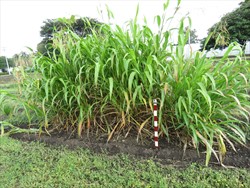 Sorghum halepense , an erect, rhizomatous, perennial
Sorghum halepense , an erect, rhizomatous, perennial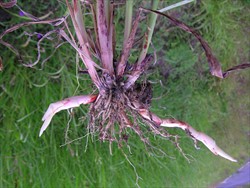 Sorghum halepense rhizomes
Sorghum halepense rhizomes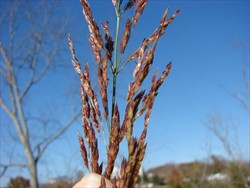
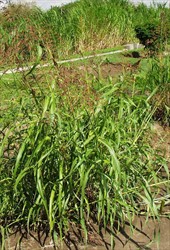 Sorghum x almum plant
Sorghum x almum plant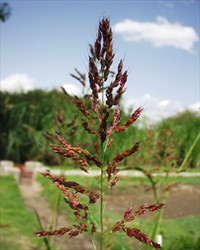 S. x almum inflorescence
S. x almum inflorescence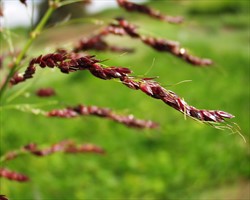 S. x almum raceme and spikelets with awns
S. x almum raceme and spikelets with awns